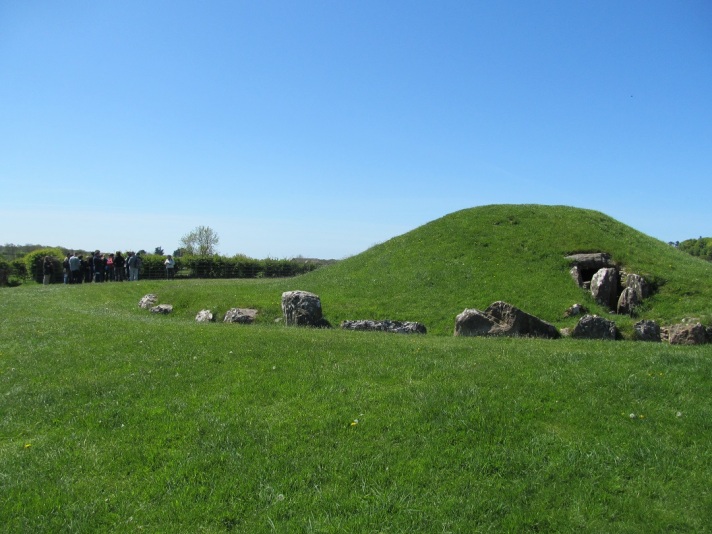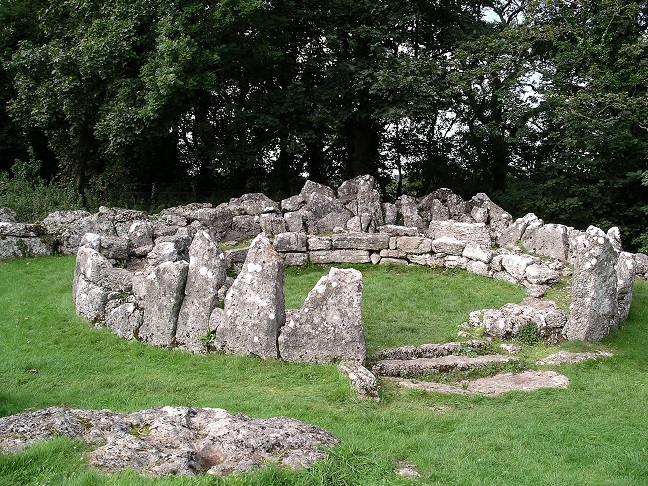Bryn Celli Ddu (pronounced Brin Kethli Thee)
This is not a blog post about the enigmatic and complex Neolithic monument Bryn Celli Ddu – despite the fact that this Anglesey megalith has all sorts of weird and wonderful tales to tell.

This is not a blog post about the concrete super-structure that holds together and supports the wrong-headed reconstruction of a central cairn.

This is not a blog post about the flowers and the coins and the bones, offerings left within the chamber and at the entrance to the passage which leads into the aforementioned wrong-headed reconstruction of a central cairn.

This is not a blog post about the graffiti and scrapes and scratches within the monument which have almost wholly been focused on the aforementioned concrete super-structural elements of the aforementioned wrong-headed reconstruction of the central cairn.
Nor is this a blog post about the standing stone in the chamber or the pit next to it that contained a bone from a human ear. Although now I kind of wish it was.

This is not a blog post about the bizarre standing stone covered in eccentric carvings that exists on site now as a replica, located in what may be the wrong place.

This is not a blog post about the small quartz pebble that someone has balanced on top of the aforementioned bizarre standing stone covered in eccentric carvings that exists on site now as a replica, located in what may be the wrong place.

This is not a blog post about the landscapes and manicured platform, wall and ditch that surrounds the megalithic components of the monument including the aforementioned concrete super-structural elements of the aforementioned wrong-headed reconstruction of the central cairn and the aforementioned bizarre standing stone covered in eccentric carvings that exists on site now as a replica, located in what may be the wrong place.

Nor is this is not a blog post about the ever-so-contemporary and annoyingly ambiguous noticeboards that now adorn the site, which celebrate the fact archaeologists know next-to-bugger-all about this mysterious monument.

This isn’t even a blog post about the wonderful old Ministry of Works iron sign on the roadside that advertise the existence of Bryn Celli Ddu to road users and passers by, the types of sign that was once all that was ever provided for visitors to such monuments, until it became fashionable to install the aforementioned ever-so-contemporary and annoyingly ambiguous noticeboards that now adorn the site, which celebrate the fact archaeologists know next-to-bugger-all about this mysterious monument.

No. This is a blog post about the car park for Bryn Celli Ddu. Because the car park has as its central focus what appears at first site to be a version of Bryn Celli Ddu – a version that may well have been built and designed in an alternative reality but a version nonetheless. I am not the first person to have blogged about this car park megalith – of course Howard Williams got there first and recognised at the time of his visit the quintessentially urban prehistoric nature of this tomb in the car park.
He called this monument ‘a miniature roofless replica of Bryn Celli Ddu itself’ – the Wee Ddu.

The alternative Bryn Celli Ddu was not there last time I was in this car park in 2002. Then, I was leading a student fieldtrip. All I can remember about the car park from that visit was that when we left the bus to head onto the site, the coach driver took the opportunity to empty his chemical toilet over a fence. (I don’t have any pictures of that ghastly event.) In fact, this monumental addition to the visitor experience here was only built in 2014.
This new monument consists of an open circular chamber with a short entrance passage on one side. The exposure of the central area of the monument gives the impression that it has undergone the megalithic equivalent of a craniectomy, with the top completely removed. The interior consists of a circular flat area some 4m in diameter, with a low wall surrounding this upon which I presume one is encouraged to sit and pause awhile before or after a long drive. While doing this one can lean back onto a circle of flat stones set into a bank that surround the interior and define the central chamber as a whole. The impression is a glorified megalithic park bench.


Built into this round monument are three curious and rather small trilithons. The dynamic nature of this monument is illustrated by the fact that these have become noticeboards since Howard Williams visited in early 2015. At that time, these little trilithons were spaces that had been filled with dry stone walling: he noted a similarity to other modern trilithons at the ‘Druids Temple’, Masham and he’s right.

Now however these trilithons have become frames for three fancy new noticeboards, adorned with wonderful Aaron Watson images and dreamy words about other archaeological sites in the vicinity such as the amazing Llyn Cerrig Bach hoard.

The whole affair is surrounded by elements of a stone circle, which consists of big stones that actually look exactly like the kind of boulders that sit on the grassy verges of about 50% of car parks in the UK.
‘What is going on here?’ Howard asks in a different and more eloquent form of words during a moment of uncharacteristic indecision.
“Is this a sanctioned ancient monument or the creation of some rogue megalithic artist? Is this a ceremonial feature built to serve the modern Pagans who utilise Bryn Celli Ddu for their ceremonies? Is it a megalithic picnic area for visiting school groups? Is it indeed new or was it protected and cloaked by spells during my last visit? Cadw’s website conceals well this new megalithic monument. Who out there can unlock its secrets and mysteries?”
I don’t claim to be able to make sense of this addition to the rich prehistoric landscape around Bryn Celli Ddu although that won’t stop me trying (!). This seems to be part of an attempt by CADW to add depth to the visitor experience, to give the impression that as soon as you turn off the road and step out of your car that you are somewhere different in time, as well as space. This is a place where the Neolithic is mysterious but also cool, colourful and funky. A place you can crawl all over and get your hands dirty. A car park that is no longer accessible to coaches with full toilets as half of the space is now taken up by a new megalithic monument.
The car park could even be a destination in its own right – the lengthy access path to the monument precludes some with mobility problems making it, so why not stay in the car park and still have a megalithic experience? Actually, this makes sense to some, as one review of the site on Trip Advisor suggests that the black metal fence around Bryn Celli Ddu makes it look as if it is ‘trapped in a municipal car park’. Car park prehistory indeed.
An extravagant noticeboard stuck onto another standing stone appears to be another recent addition to this complex.

And now it all starts to make sense. An exchange of tweets literally as I wrote this post clarified that this circular monument has a very specific role: as a ‘orientation hub for the island’s prehistoric sites’ according to archaeologist Ffion Reynolds (follow her! She is @caws_llyffant). This makes sense – it is the best-known prehistoric site in Anglesey and not far from the bridges, and so an ideal starting point for anyone doing a tour of the island’s archaeology. And it makes even more sense that the monument actually looks a lot like one of the Bronze Age stone roundhouses at Din Lligwy, also on Anglesey. This is not actually the Wee Ddu, but the Wee Anglesey.

The clarification on the meaning of this monument from Ffion gives me an excuse to mention some work she has been doing with others at BCD in recent years. Since the monument was excavated and imaginatively reconstructed by WJ Hemp in 1925-29, there has been much debate about the phasing and form of the monument, as well as its chronology. This has become clearer in recent years. A definitive review of the site based on fresh dating was published in the Proceedings of the Prehistoric Society in 2010 by Steve Burrow. More recently survey work by amongst others Seren Griffiths, Ben Edwards and Ffion have shown through impossibly high-tech sounding technique called electrical resistance tomography (ERT) that the enclosure around the tomb may have had a bank and therefore might have been a henge, with interesting implications.
Aside from this good old interpretive work, Bryn Celli Ddu has been the focus of several community and open day events in recent years, including a renewed focus on the alignment of the tomb’s passage on the midsummer sunrise. Ben, Seren and Ffion are running a community archaeology project in and around the site next month with an open day on 18th June 2016 having started their project in 2015. And there is now even a comic based on the site, commissioned by CADW and created by John Swogger.

So this really hasn’t been a blog post about Bryn Celli Ddu. It has become a blog post about how archaeologists are adapting to modern technologies and adopting new ways to engage with the public in interesting analogue and digital ways. I don’t think all of it works, such as the new noticeboards on site which lack helpful basic information for the casual visitor, but as an overall experience it holds together rather well. There is something refreshingly timeless about this site, with something for everyone, whether it be the lovable old Ministry of Works roadside sign, or the experience of clambering into a tomb (concrete superstructure or not, this is always fun), or the flowers carefully placed and left undisturbed in and around the passage grave.
There is even something for the urban prehistorian.
Sources and acknowledgements: thanks firstly must go to Seren Griffiths and Ben Edwards who were our guides over the weekend of 13-15th May when the Neolithic Studies Group visited Bryn Celli Ddu during a trip to Anglesey. Thanks also to Ffion Reynolds for clarifying the nature of the car park monument, and to Howard Williams for beating me to it! I hope he doesn’t mind me quoting from his blog and using an image for comparative purposes. The definitive modern account of the monument by Steve Burrow is Burrow, S 2010 Bryn Celli Ddu passage tomb, Anglesey, PPS 76, 249-70, from which some information in this post was derived. To find out more about the comic for Bryn Celli Ddu, go to this CADW webpage. The image of the Din Lligwy house is in the public domain.

Reblogged this on The Reader Online.
Your description of Celli is wrong, this is how its done, place tounge at top of mouth as you do when saying the letter L, then and blow at the same time. See video clip for more info .https://www.youtube.com/watch?v=hQBGOb7iQZ0
Thanks for that.